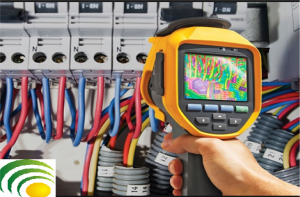WHAT IS ELECTRIC THERMOGRAPHY ? 
With the increasing power demand, the complexity of the power system is also increasing as the world progresses. In parallel to that the fault current level is also increasing. In order to protect the electrical devices and components, different methods are adopted to control the fault current and mainly to prevent the cause of fault current.
The unfavorable conditions such as Poor connections, unbalanced loads, deteriorated insulation and other potential problems are really a problem. Excess power use, increased maintenance costs, or catastrophic equipment failure are the main problems that resulting in unscheduled service interruptions, equipment damage etc. These problems may lead to resulting other problems in energized electrical components which can be detected by a non destructive test method called Thermography. The process which called as the Thermographic Testing of Electrical Equipment.
THERMOGRAPHY WORKING AND USES
In energized electrical systems, the generated heat is related to the amount of current flowing through the system and the resistance of the individual system components and connections within the system. When the components deteriorates, their resistance also increases which result in increase in heat. The higher the temperature, the higher will be the resistance. A poorly made connection has a higher resistance than a well-made connection.
Another name of Thermography is called the infrared inspection. Because the heat emitted from the surface of an object is actually in the form of infrared radiation. With the help of test instruments , it is possible to detect and convert the infrared radiation into either a temperature value or a thermal value. That way the thermal condition of the object are assessed at the time of measurement. An good example of infrared thermal imaging device is nothing but an infrared camera.
Thermographic scan is needed to perform at least annually on certain Businesses with high electrical demands. This is applicable on critical systems, such as circuit panels, switch gears, and transformers. The greatest need for thermographic scan are heavy equipment, distribution systems etc which are of high power consumption category. Power consumption, age of the electrical systems and types of equipment etc are schedule to re scan is on the basis of the previous scan result. This work is done by a qualified electrician.
BENEFITS AND ADVANTAGE
Failure of electrical insulation, terminals, and related components is the main reason why the fire cause in an electrical system. Serious injury or death from electrocution happens when the employees are exposed to live electrical circuits. The likelihood of breakdown of the electrical wires and related components is reduced by detecting the high-resistance connections and repairing them.
A main advantage is nothing but the cost savings from energy conservation, lower outage and repair costs. The high current draw can cause critical electrical circuit components, such as fuses, circuit breakers, and transformers, to fail prematurely. This is because when current flow increases, the power consumption also increases which leads to the premature failure of components.

